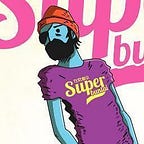The Design question: ’Whose Future’ or ‘Who is Future’?
I grew up in post-liberalization 90’s India. I was lucky enough to be able to access a steady diet of western popular culture in the form of cartoons, video games and comic books — think men in capes that can fly and shoot lasers from their eyes, Turtles who are trained in the martial arts and love Pizza, Intergalactic peacekeeping monks known as the Jedi. Most of these espoused western cultural values and ideas that seemed fantastical at the time, even if they were based on realities elsewhere. Since they didn’t fit within the context of my Indian reality, they quickly became sweet escapes from the humdrum every day.
When our MA Service Design cohort was tasked with thinking of a future service to tackle the imminent climate emergency in Southwark, it triggered the memory of one such cartoon — Captain Planet & the Planeteers (1990–1994) — where a diverse team of “Planeteers” are able to combine their elemental powers (Earth, Fire, Water, Wind, Heart) to summon superhero Captain Planet. He works with the Planeteers to defend Earth from pollution caused by criminals and villains.
For 10-year-old me, this was the first time, that fantasy presented itself as plausible fiction — a reality that probably existed and could very well be the future in my reality too. It also made me painfully aware of climate change and as well as its solution; primarily by personifying both the problem (as villains) and the solution (as Captain Planet and the Planeteers). Present-day me, reframed this as a ‘What if’ question.
I was tempted to give the future a face — for one, it could help provide you with a solid visage of something that isn’t really tangible. But when designing for climate change it could very well become an anticipatory design approach.
Personifying the Future as Service Designers
Service Design thinking often encourages us to look at the world through what I like to call a Prism & Kaleidoscope approach. We break down systems into key components and then visualize new arrangements. Taking this approach, we broke the future down into what it could mean an:
- Is the future a place? Or is it time? Or both?
- If the environment can be seen as a person (Like Captain Planet) to aid a narrative can the future be a person too?
- Can this person also be a tool? Can this tool aid design thinking?
With the above process, I proceeded to break down the Future into different elements and possibilities and then reframed it to bring a personified aspect front and centre — The idea of Future as a perennial stakeholder in any climate action that we may seek to bring about with our service.
In After Man — A Zoology of the Future (1981) Dougal Dixon explores a world without people focusing exclusively on biology, meteorology, and environmental sciences. His speculative world is rooted in a thorough understanding of evolutionary mechanisms and processes. (Dunne & Raby, 2013) What Dixon engages in is grounded in principles of system thinking. In addition to being a canonical example of didactic world-building, it also shows that futures can be interpreted as a different set of elements (or actors and stakeholders in design-speak).
Personifying the future into a stakeholder attempts in part what Dixon attempted — to be able to render a future in tangible flesh and bones; to be able to see the future as a sentient, living breathing entity capable of influence and of being influenced. Perhaps then, the future becomes open to interpretation through lenses of Human-centred design, making it part of a system that one is designing for.
For the unit, my team’s focus is on addressing Consumption and the Circular Economy to mitigate Southwark’s impact on climate change. We zoomed out to study the Borough’s structures and realised that the vastness of the ‘system’ could overwhelm not only our process but also our solution. By imagining Future among stakeholders, we were actively able to simulate a scaled-down version of it as an active participant in its own development.
The Future isn’t alone
Problems cannot be solved unless they are confronted and if they are to be solved it will not be by chance but, as said, by design (Fry,2009)
Only by acknowledging and confronting a problem can there be a basis for its disruption through design.
So who confronts our stakeholder? Are there other stakeholders like the future? What is their relationship with each other?
If we accept that Future can be a stakeholder, then we are inclined to accept that so can the Past and the Present. When not restricted by the linear progression that forms the identity of time, Past and Present are not predecessors to the Future but siblings that coexist, challenge and confront the future often determining its path.
As the team zeroed in on tackling consumption and circularity, through this design approach we have adopted a more people-centred focus. We have begun to look at different stakeholders in the present and speculate their existence in future as an integral part of the solution. We have begun to examine how can we design a shared understanding and the relationships between different people ie. residents of Southwark and the Southwark Council. As we articulate desires and fears of the personified Future (Bland & Westlake, 2013), we also do so for the people that are active participants in this future. Perhaps we would even go so far as to identify a person as our artefact.
Will Future continue to be seen as a stakeholder as our understanding evolves? or will it evolve to become an idea, bigger than a body can contain? That is something I intend to find out as we cover more ground in our research.
